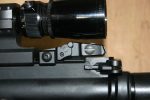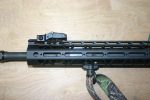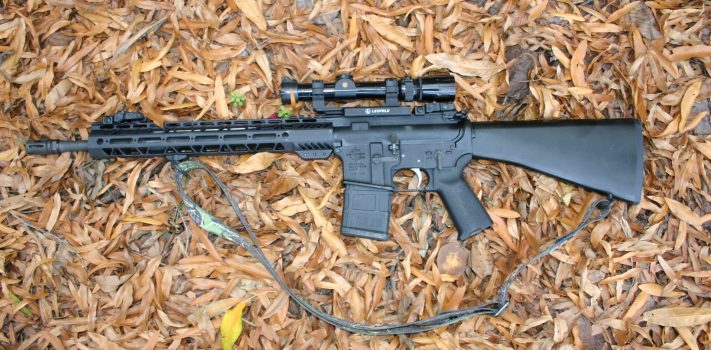(Continued from Part 1. This concludes the article.)
The mid-length and rifle length gas systems are known for operating the action more smoothly when compared to the carbine length system. The mid length gas system increases for the carbine length barrel. The longer gas tube gives a longer bolt carrier dwell time in the rifle, which lets all the moving pieces work a little more slowly and less violently but still quickly and energetically enough to let the bolt carrier move back fully and allow the bolt to strip the next round off of the magazine reliably. The entire recoil system is stressed less, reducing wear and tear and malfunctions during normal conditions.
The bolt carrier group contains the bolt, bolt cam, gas key, and the firing pin. For this vital part I try to keep it simple. A steel, mil-spec bolt carrier group from a quality manufacture is often the best answer and is a proven performer. Good ones are often tested using Magnetic Particle Inspection during manufacture to look for defects. The bolt can be purchased separately from the bolt carrier but is normally purchased as part of a high quality bolt carrier group.
The upper receiver is the M4 version which has a factory M4 Picatinny top rail to support the rear sight and the scope base. It should also have enhanced M4 cuts for the feed ramps, which are machined at a shallower angle. This newer feed ramp angle is much more forgiving during the feed cycle and easier on the nose of the bullet. Almost any upper from a reputable dealer will work well.
The lower receiver has the serial number, contains the trigger group, supports the buttstock, and houses the magazine. The trigger mechanism has a disconnector that keeps the rifle from firing more than one shot per pull of the trigger. The proper operation of the disconnector function is critical to safety and should be verified before the rifle is fired.
There are three common types of buttstocks, the telescoping or collapsible, the fixed A1 length, and the fixed A2 length, with the A2 length being the longest. I like the A1 length with a trapdoor that lets you store a few things in it, thereby keeping those things with the rifle at all times. One such item should be whatever needed to remove and replace the scope base from the upper receiver. Another should enable you to install the rear backup iron sight if it has been stored in the buttstock compartment.
The buttstock contains the action spring and its buffer. Keep in mind that the buffer can be changed to a heavier one to soften recoil but in rare cases this can cause malfunctions such as short stroking and subsequent failure to feed. I use a standard action spring and a slightly heavier buffer with good results.
Another advantage is that the fixed stock usually allows a better cheek weld when aiming. The rest of the smaller upper and lower receiver parts are Mil-spec. Again, go to a quality manufacturer for these parts since they can vary in quality.
 A rifle like this should have optics. Zero and master the use of iron sights first and then move on to a scope. Optics are pretty intuitive and allow you to better utilize the full mechanical accuracy potential of the rifle. I use a very solid basic scope mount. It is not sleek or pretty but it is strong. The scope itself should be variable with a 2 power or so lower end for a big field of view when needed, no projecting knobs, and a simple duplex reticle. Range-finding setups in the scope are not needed. Flip-up lens protectors keep dust and trash out of the scope. Dust protectors should be on both front and back. The rear one on my rifle recently broke and has not yet been replaced.
A rifle like this should have optics. Zero and master the use of iron sights first and then move on to a scope. Optics are pretty intuitive and allow you to better utilize the full mechanical accuracy potential of the rifle. I use a very solid basic scope mount. It is not sleek or pretty but it is strong. The scope itself should be variable with a 2 power or so lower end for a big field of view when needed, no projecting knobs, and a simple duplex reticle. Range-finding setups in the scope are not needed. Flip-up lens protectors keep dust and trash out of the scope. Dust protectors should be on both front and back. The rear one on my rifle recently broke and has not yet been replaced.
Flip-up backup iron sights are ideally zeroed and left in place. If your scope mount will not allow you to keep the rear backup iron sight mounted on the rifle all the time then remove it after zeroing and keep it in the buttstock. It should return to zero pretty well when reinstalled.
Choice of magazines should be conservative. I like the PMAG 20-round polymer magazines, although quality-made metal body magazines also work quite well. All your magazines should have anti-tilt followers. There is nothing wrong with 30-round magazines except that they make the rifle functionally “taller” top to bottom and are heavier when fully loaded. In any case fire at least a few rounds from each magazine you purchase to sort out any with severe issues. Look for sales on quality magazines. You should keep extra magazines on hand.
 The importance and utility of a sling is easily overlooked. A basic, adjustable length two point sling that attaches to the front and rear of the rifle has stood the test of time. While it is slightly less versatile than a multipoint sling it is simpler, does not get in the way as much, and is quite functional. A quick-release sling swivel on the front will allow you to quickly separate the upper and lower for cleaning.
The importance and utility of a sling is easily overlooked. A basic, adjustable length two point sling that attaches to the front and rear of the rifle has stood the test of time. While it is slightly less versatile than a multipoint sling it is simpler, does not get in the way as much, and is quite functional. A quick-release sling swivel on the front will allow you to quickly separate the upper and lower for cleaning.
Being able to sling your rifle safely will allow you to do many tasks without losing contact with the rifle when you set it down somewhere. A slim front handguard that uses the M-lock system of fasteners will allow you to attach a sling at any point. The one used here is light and allows the barrel to float, so sling tension does not then affect the point of aim. A “hasty” sling is a surprisingly good way to help stabilize the rifle during firing.
When you first fire and zero the rifle you will probably use a set of bags to support it at the gun range. Don’t get hung up on accuracy off of a rest. A solid, round, repeatable 2 inch group at 100 yards will do just about anything that you need done. Most barrels will do far better with any reasonable ammunition.
Be aware that once the rifle is zeroed using one specific ammunition the rifle zero will often change if a different type of ammunition is used. With a scope, a common range to zero at is 200 yards. Do some research on this to decide what zero works best for you and spend the range time to get the rifle zeroed correctly. Learn about trajectory. If possible use a chronograph to get the exact bullet velocity for your ammunition and then use that figure when you look at the trajectory tables. When you are done shooting clean the rifle religiously. Store it safely and store it clean.
You have to use good ammunition for best performance. I recommend against using steel case ammo. Military spec ammo from reputable suppliers is fine for practice and some competition, but accuracy can vary by manufacturer.
I normally use my own handloads in the field with great success. I check each finished round with a cylindrical type case gauge which checks for external case dimensions, headspace, and case length in one step. I also use commercial soft points in the field. These feed perfectly for me due to the M4 feed ramp. Once you find ammunition that shoots well you should stock up on that ammo to some extent. This will insulate you a little from availability ups and downs in the ammunition market.
Now that you have your rifle please remember that gun safety is critical and starts between the ears. You need a full understanding of how the firearm is operated. This is referred to as the “Manual of Arms” and one exists for every different model of modern firearm. Information includes how to operate the rifle as well as how to perform common activities such as safely loading and unloading it. You will need to learn how to properly clean and inspect this model of rifle. There are good guides and books out there for the rifle as well as reprints of U.S. military Field Manuals for the M16. These have a lot of good basic information that will apply to the AR-15.
Practice good safety at all times. Make it a habit. One safe way to carry the rifle when you have it with you is to start by pulling back the charging handle while there is no magazine inserted and inspecting the chamber to make sure it is empty. Then release the charging handle so the bolt carrier is fully forward on the empty chamber. At this point the rifle is cocked and you can engage the safety. Lastly insert a full magazine. Tug on the bottom of the magazine to make sure it is locked in place.
Now you have the safety on, the bolt forward with no round in the chamber, and the loaded magazine is in place. Because the chamber is empty the rifle simply cannot fire. To fire a rifle in this condition you have to first fully rack and release the charging handle to put a cartridge in the chamber and then move the safety to the “Fire” position.
One of my favorite safety admonitions is to always use the safety, but never trust the safety. Another is that the chamber is not empty until you visually or mechanically verify that it is empty.
Jeff Cooper created and advocated his own set of gun safety rules. You might want to review these and put some thought into their application. Here they are:
1. All guns are always loaded. Even if they are not, treat them as if they are.
2. Never let the muzzle cover anything you are not willing to destroy.
3. Keep your finger off the trigger till your sights are on the target.
4. Identify your target, and what is behind it.
Consider enrolling in training classes and find local competitions such as Service Rifle to better test your gear and skills. You can have a little fun challenging yourself and improving your skill level. I find that state-organized Hunter Safety courses are broad and somewhat basic but excellent in exposing you to generic safe gun handling and actual field scenarios. Try to get some field time in, learn to safely shoot from field rests at unknown distances, and practice as frequently as possible.
Be safe.










